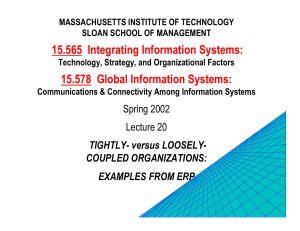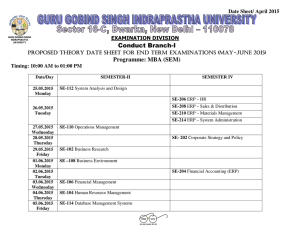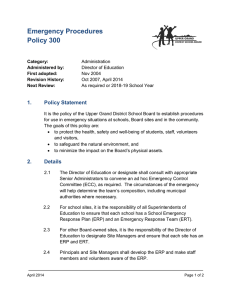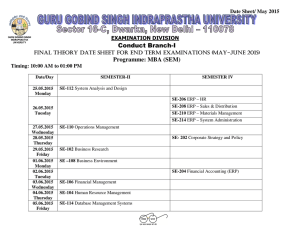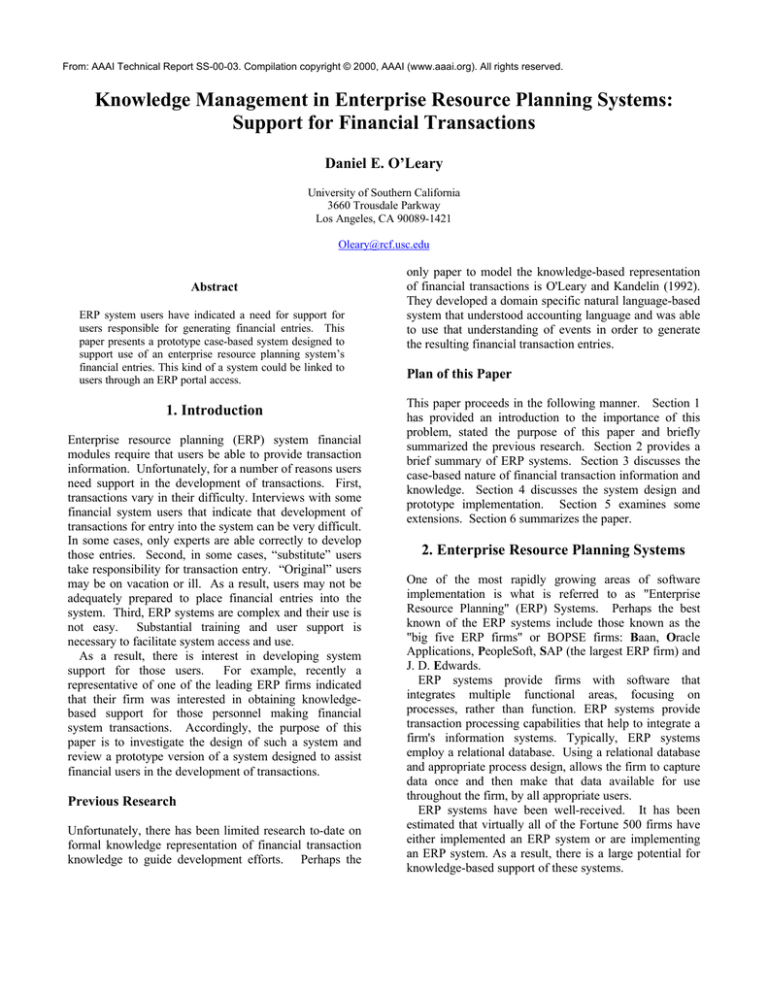
From: AAAI Technical Report SS-00-03. Compilation copyright © 2000, AAAI (www.aaai.org). All rights reserved.
Knowledge Management in Enterprise Resource Planning Systems:
Support for Financial Transactions
Daniel E. O’Leary
University of Southern California
3660 Trousdale Parkway
Los Angeles, CA 90089-1421
Oleary@rcf.usc.edu
Abstract
ERP system users have indicated a need for support for
users responsible for generating financial entries. This
paper presents a prototype case-based system designed to
support use of an enterprise resource planning system’s
financial entries. This kind of a system could be linked to
users through an ERP portal access.
1. Introduction
Enterprise resource planning (ERP) system financial
modules require that users be able to provide transaction
information. Unfortunately, for a number of reasons users
need support in the development of transactions. First,
transactions vary in their difficulty. Interviews with some
financial system users that indicate that development of
transactions for entry into the system can be very difficult.
In some cases, only experts are able correctly to develop
those entries. Second, in some cases, “substitute” users
take responsibility for transaction entry. “Original” users
may be on vacation or ill. As a result, users may not be
adequately prepared to place financial entries into the
system. Third, ERP systems are complex and their use is
not easy. Substantial training and user support is
necessary to facilitate system access and use.
As a result, there is interest in developing system
support for those users.
For example, recently a
representative of one of the leading ERP firms indicated
that their firm was interested in obtaining knowledgebased support for those personnel making financial
system transactions. Accordingly, the purpose of this
paper is to investigate the design of such a system and
review a prototype version of a system designed to assist
financial users in the development of transactions.
Previous Research
Unfortunately, there has been limited research to-date on
formal knowledge representation of financial transaction
knowledge to guide development efforts. Perhaps the
only paper to model the knowledge-based representation
of financial transactions is O'Leary and Kandelin (1992).
They developed a domain specific natural language-based
system that understood accounting language and was able
to use that understanding of events in order to generate
the resulting financial transaction entries.
Plan of this Paper
This paper proceeds in the following manner. Section 1
has provided an introduction to the importance of this
problem, stated the purpose of this paper and briefly
summarized the previous research. Section 2 provides a
brief summary of ERP systems. Section 3 discusses the
case-based nature of financial transaction information and
knowledge. Section 4 discusses the system design and
prototype implementation. Section 5 examines some
extensions. Section 6 summarizes the paper.
2. Enterprise Resource Planning Systems
One of the most rapidly growing areas of software
implementation is what is referred to as "Enterprise
Resource Planning" (ERP) Systems. Perhaps the best
known of the ERP systems include those known as the
"big five ERP firms" or BOPSE firms: Baan, Oracle
Applications, PeopleSoft, SAP (the largest ERP firm) and
J. D. Edwards.
ERP systems provide firms with software that
integrates multiple functional areas, focusing on
processes, rather than function. ERP systems provide
transaction processing capabilities that help to integrate a
firm's information systems. Typically, ERP systems
employ a relational database. Using a relational database
and appropriate process design, allows the firm to capture
data once and then make that data available for use
throughout the firm, by all appropriate users.
ERP systems have been well-received. It has been
estimated that virtually all of the Fortune 500 firms have
either implemented an ERP system or are implementing
an ERP system. As a result, there is a large potential for
knowledge-based support of these systems.
3. Financial Transaction Characteristics
5. Extensions
An important characteristic of financial transactions is
that they tend to repeat themselves.
First, some
transactions occur at regular intervals over time. Second,
other events frequently occur. For example, an
overwhelming majority of a firm's financial transactions
are purchases or sales. Third, even transactions that are
not frequently occurring, may repeat themselves, if only
occasionally. This repeating nature leads us to suggest
that a case-based reasoning approach is an appropriate
vehicle to capture and represent knowledge about
financial transactions.
Because transactions repeat themselves, capturing
previous transactions and reusing those transactions can
provide support to financial system users. This capability
suggests that previous entries could be used to guide user
construction of financial entries.
Although transactions basically "repeat themselves"
they are not always identical, even if it is only the dollar
amounts that change. As a result, case-based information
about financial transactions is not intended to replace the
user, but only provide support.
This paper has focused on supporting ERP system users
in the area of financial transactions using case-based
reasoning. Additional system support could be generated
to support users of other modules.
A prototype system design, based on REA, was
presented for capturing case-based knowledge about
financial transactions. That approach centered on the
event of concern. At this point, the system has been
developed as a proof of concept. As a result, the system’s
case base and approach is minimal and could be extended.
In addition, ultimately for such a system to be used as
part of an ERP system would require integration into the
ERP system or into the portals that are being generated by
ERP vendors. Clearly either approach is outside the
scope of this paper.
One approach would be to embed the system into an
ERP portal (e.g., figure 1). Similar to other knowledge
support that is available from the portal, a simple virtual
tab or link could tie the portal to the transaction system
support system. Using this approach, such a system could
be loosely linked, rather than tightly integrated into the
ERP.
4. A Prototype System
6. Summary
Using the M.4 shell, a preliminary system design was
developed that exploits the basic underlying database
requirements for financial transactions (see exhibit 1 for a
simple case and a few rules). In particular, research
suggests that ERP systems employ a database schema that
generates information on resources, events, agents and
locations from the financial transactions.
As a result, the underlying database structure is used as
the basis of the cases. In particular, the Resources –
Events – Agents – Location (REA) is used as the basis of
capturing information about the entries for the case
library. REA (McCarthy 1982) provides a theoretical
structure to accounting and other database applications.
The initial and driving matching criteria for the cases in
the system are the events (E), which the system is
designed to process. Additional information in the cases
includes the resource (e.g., cash) and the direction of
change in the resource (e.g., cash increasing), the external
agent (e.g., the particular client) and the location for
which the event is occurring (e.g., central office). In
addition, the resulting financial system entry, in terms of
debits and credits also is captured. Although REA does
not require a debit – credit structure, ERP systems still
employ that approach. As a result, the system is designed
around a debit – credit structure.
Enterprise resource planning (ERP) systems are receiving
widespread adoption. Unfortunately, these systems are
complex. As a result, systems are being developed to
facilitate use of those ERP systems. In particular, there
has been concern by ERP firms and client firms about
supporting users of different modules. This paper has
investigated the opportunity of supporting financial
transactions. A prototype system that employed an REA
structure was developed and discussed. A number of
extensions were examined, including the potential for
linkage of such a system to users through an ERP portal.
References
McCarthy, W., “The REA Accounting Model: A
Generalized Framework for Accounting Systems Shared
Data Environment,” Accounting Review, July 1982, pp.
554-577.
O'Leary, D., and Kandelin, N., "Accountant: A Domain
Dependent Accounting Language Processing System," in
Expert Systems in Finance, D. O'Leary and P. Watkins,
1992, Elsevier.
Figure 1
Exhibit 1
/*------------------------ object class definition ----------------------*/
classdef(entries) = [supers = []].
/*------------------------ class instance of entry event cases -----*/
instdef(sales_event) = [
class = entries,
event_category = sales_event,
resource_increasing = cash,
location = central_office,
external_agents_impacted = customers,
debit = cash,
credit = sales ].
/*-----------sample goal, questions, legal values and rules--------------*/
goal = [final_conclusion].
question(event_category) = 'What category of entry are you considering?'.
legalvals(event_category) = [sales_event, purchase_event].
question(status) = 'Would you like to continue considering case attributes?'.
legalvals(status) = [continue, all_done].
if event_category = Category and
classinst(entries, ENTRIES) and
ENTRIES <- getslot(event_category) = Category and
ENTRIES <- getslot(resource_increasing) = C and
display(["Found a resource increasing-based match for ",C,nl])
then conclusion_match = good.
if event_category = Category and
classinst(entries, ENTRIES) and
ENTRIES <- getslot(event_category) = Category and
ENTRIES <- getslot(event_category) = D and
display(["for a ",D,nl])
then event_conclusion = good.
if conclusion_match = good and event_conclusion = good and status = all_done then final_conclusion =
good_match.


